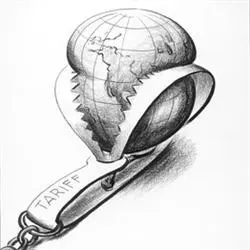Understanding the Economic Impacts of Tariffs – A Deep Dive from Extreme Investor Network

When it comes to tariffs, the debate often centers on their supposed effects on inflation. Recently, Treasury Secretary Scott Bessent made headlines with his assertion that these tariffs are simply a “one-time price adjustment.” However, at Extreme Investor Network, we firmly believe that such a perspective significantly underestimates the complex and often detrimental economic consequences of tariffs.
Breaking Down Bessent’s Assertions
To put Bessent’s claims in context, he suggested that tariffs merely lead to temporary price changes, hinting at a hope that inflationary pressures would somehow stabilize. His analogy to the previous misjudgment regarding “transitory” inflation raises eyebrows. While it’s true that some adjustments in pricing can occur, the reality is far more intricate and impactful.
Bessent’s statement, “across the continuum, I’m not worried about inflation,” reflects a common underestimation of how tariffs function in a modern economy where global supply chains are intricately connected. In reality, tariffs are not merely simple adjustments; they can set off a chain reaction that reverberates through the entire economy.
The True Ripple Effects of Tariffs
Let’s take a closer look at the economic mechanics involved. When tariffs create a price increase for imported goods, such as steel, the outcome is not limited to that one product. Domestic manufacturers faced with elevated costs will not absorb these additional expenses; they will inevitably pass them down the line. This means that products reliant on steel—everything from automobiles to household appliances—will see prices hike as manufacturers strive to maintain their profit margins.
These are by no means isolated incidents; the costs continue to ripple through the supply chain. Increased prices prompt businesses to reassess their strategies, often resulting in reduced hiring or even layoffs, which can stifle economic growth.
The Wage-Price Spiral: A Dangerous Cycle
One significant consequence of rising prices is the pressure it places on workers. As consumers face higher living costs, they naturally demand increased wages to sustain their standard of living. Economists refer to this situation as a wage-price spiral—the very phenomenon that often deepens inflationary pressures within an economy.
Higher wages can initially seem favorable, but they also compel businesses to raise their prices once again to cover the increased labor costs. This cycle creates a self-perpetuating loop that can lead to prolonged economic stagnation, a situation familiar to many over the past few years.
The Bigger Picture: Stagnation and Economic Health
In light of these factors, it becomes increasingly evident that tariffs impose more harm than good. Rather than serving as a protective measure for the local economy, they can foster a combination of reduced supply and skyrocketing prices. Ultimately, this leads to economic stagnation—harming the very individuals the tariffs purportedly aim to protect.
At Extreme Investor Network, we encourage our readers to adopt a broader view of economic policy, recognizing that decisions made at the administrative level can have extensive and lasting impacts. Rather than viewing tariffs through a simplistic lens, it is crucial to understand their role in shaping our economy’s future.
Conclusion: A Call for Informed Economic Policy
As the conversation surrounding tariffs continues, it’s essential for policymakers to grasp the nuances involved. Recognizing the wider implications of tariffs is crucial to fostering a healthy and sustainable economic environment. At Extreme Investor Network, we strive to keep you informed with insights that delve into these complexities, helping you navigate the ever-evolving landscape of economics.
For more in-depth analysis and expert insights that go beyond surface-level discussions, stay tuned to our blog and join the conversation. Together, we can foster a more informed public discourse that will shape the future of economic policy and investment strategies.

